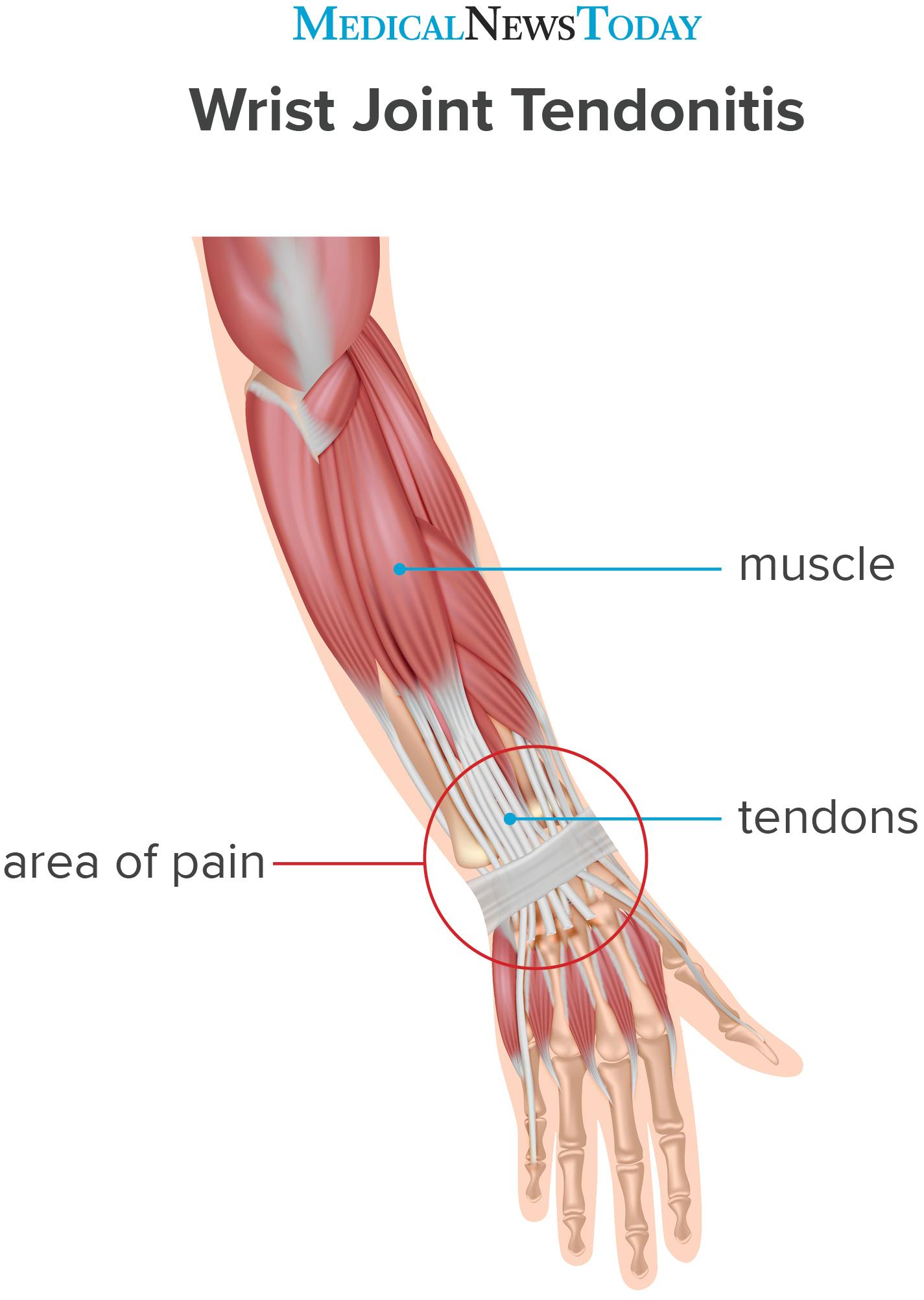Wrist tendonitis is the inflammation of a tendon in the wrist. Tendons are thick, fibrous cords that connect muscles to bones.
Tendonitis can occur as a result of an injury or repetitive motion that causes the tendon to rub against other bodily tissues, such as bone.
A person’s wrist contains many tendons. Together, they allow movement of the wrist, hand, and fingers. Tendonitis can develop in any of the tendons in the wrist as a result of injury or overuse.
Keep reading for more information on the symptoms and causes of wrist tendonitis and the treatment options available.
The most common symptom of wrist tendonitis is pain. The pain may be dull, and it may worsen with movement of the wrist.
Other potential symptoms of wrist tendonitis include:
- warmth and redness
- swelling and inflammation, which can reduce the mobility of the wrist and make repetitive activities, such as texting or typing, more difficult
- a grinding sensation or creaking noise when moving the wrist
- weakness in the wrist

The most common causes of wrist tendonitis are repetitive movement and overuse, for example, due to:
- typing and using a computer mouse
- playing video games
- texting
- writing with a pen and paper
- performing repetitive physical tasks, such as hammering or chopping wood
- playing sports that require the use of the wrists
The following factors may also cause or contribute to wrist tendonitis:
- age
- poor posture in the wrists
- poorly aligned joints
- an acute injury from a fall or other impact
- diabetes
A person may be able to treat minor cases of wrist tendonitis at home.
Some potential home treatments for wrist tendonitis include:
- avoiding any repetitive activities that could have caused or contributed to the condition
- applying ice to the wrist to reduce inflammation
- wearing a splint to minimize movement and prevent further injury
- taking over-the-counter (OTC) pain relievers and nonsteroidal anti-inflammatory drugs (NSAIDs) to reduce inflammation
A person should see their doctor if their wrist tendonitis does not improve, or they suspect that the condition is a result of an injury. A doctor will be able to assess the severity of the tendonitis and suggest additional treatment options.
There are several potential treatment options for wrist tendonitis. The type of treatment that a doctor recommends will depend on the cause and severity of the condition.
Some nonsurgical options for treating wrist tendonitis include:
- gentle stretching exercises
- bracing or splinting the wrist to reduce movement and prevent further injury
- NSAIDs to reduce pain and swelling
- a steroid injection into the wrist to reduce inflammation
- occupational therapy to help people engage in activities that they may otherwise find difficult
If these treatments fail, or there is damage to the tendon, a person may need surgery to correct their wrist tendonitis. The specific form of tendonitis will determine whether a person is a candidate for surgery, which is not beneficial in all cases.
During surgery, the surgeon will make a small incision in the wrist and locate the damaged tendon. They will then typically release the sheath surrounding the tendon. This minimally invasive procedure usually requires only local anesthesia. However, more complicated cases of wrist tendonitis may require general anesthesia.
The following tips can help people prevent wrist tendonitis:
- avoiding repetitive activities that can cause or contribute to wrist tendonitis, where possible
- taking regular breaks during repetitive activities that involve the wrists
- wearing supporting braces when doing a repetitive task, such as typing, or other activities that may put a strain on the wrists
- performing exercises to stretch the wrists
Wrist tendonitis refers to inflammation of a tendon within the wrist. This condition typically causes pain and swelling, and it may result in a reduced range of movement in the wrist.
People can usually relieve the symptoms of tendonitis with minimal treatment, such as stretching, splinting, and icing. OTC medications can also help control pain and swelling.
A person can take preventive steps to avoid wrist tendonitis. These include exercising the wrists and taking regular breaks from repetitive activities that may strain them.
If home treatments do not alleviate wrist tendonitis, a person should see their doctor. The doctor will examine the wrist and recommend additional treatment options. In rare cases, a person may need surgery to correct wrist tendonitis.
Tendonitis can go away completely in time, but some people may need to learn to manage chronic tendonitis.
Source link
 Black America Breaking News for the African American Community
Black America Breaking News for the African American Community